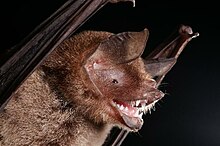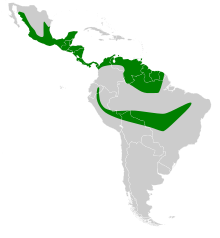
Echolocation, also called bio sonar, is a biological active sonar used by several animal groups, both in the air and underwater. Echolocating animals emit calls and listen to the echoes of those calls that return from various objects near them. They use these echoes to locate and identify the objects. Echolocation is used for navigation, foraging, and hunting prey.

The Mexican free-tailed bat or Brazilian free-tailed bat is a medium-sized bat native to the Americas, so named because its tail can be almost half its total length and is not attached to its uropatagium. It has been claimed to have the fastest horizontal speed of any animal, reaching top ground speeds over 99 mph (160 km/h). It also flies the highest among bats, at altitudes around 3,300 m (10,800 ft).

The family Mormoopidae contains bats known generally as mustached bats, ghost-faced bats, and naked-backed bats. They are found in the Americas from the Southwestern United States to Southeastern Brazil.

The Egyptian fruit bat or Egyptian rousette is a species of megabat that is found in Africa, the Middle East, the Mediterranean, and the Indian subcontinent. It is one of three Rousettus species with an African-Malagasy range, though the only species of its genus found on continental Africa. The common ancestor of the three species colonized the region in the late Pliocene or early Pleistocene. The species is traditionally divided into six subspecies. It is considered a medium-sized megabat, with adults weighing 80–170 g (2.8–6.0 oz) and possessing wingspans of approximately 60 cm (24 in). Individuals are dark brown or grayish brown, with their undersides paler than their backs.

The pallid bat is a species of bat that ranges from western Canada to central Mexico. It is the sole species of its genus and is closely related to Van Gelder's bat, which is sometimes included in Antrozous. Although it has in the past been placed in its own subfamily (Antrozoinae) or even family (Antrozoidae), it is now considered part of the subfamily Vespertilioninae and the tribe Antrozoini.

The big naked-backed bat, is a bat species from South and Central America.

Wagner's mustached bat is a bat species from South and Central America. It is one of the few New World bats species known to perform Doppler shift compensation behavior.
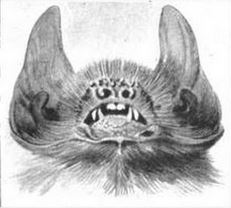
Davy's (lesser) naked-backed bat is a small, insect-eating, cave-dwelling bat of the Family Mormoopidae. It is found throughout South and Central America, including Trinidad, but not Tobago, Guyana, Suriname, or French Guiana. Specimens of this bat had been found infected with rabies in Trinidad during the height of that island's vampire-bat-transmitted rabies epidemic of the early half of the 20th century, but not in recent times.
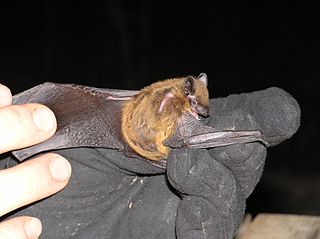
The evening bat is a species of bat in the vesper bat family that is native to North America. Hunting at night, they eat beetles, moths, and other flying insects.

The long-legged myotis is a species of vesper bat that can be found in western Canada, Mexico, and the western United States.

Sundevall's roundleaf bat, also called Sundevall's leaf-nosed bat, is a species of bat in the family Hipposideridae.

Macleay's mustached bat is a species of bat in the family Mormoopidae. It is found in Cuba and Jamaica, and is threatened by habitat loss. The species is named for William Sharp Macleay, who collected the type specimen.
The sooty mustached bat is a species of bat in the family Mormoopidae. It is found in throughout the Greater Antilles, in Cuba, Hispaniola, Jamaica, and Puerto Rico.

The lesser mouse-tailed bat is a species of microbat in the family Rhinopomatidae. Also referred to as Hardwicke's lesser mouse-tailed bat and long-tailed bat, it is named after Major General Thomas Hardwicke (1755–1835), an English soldier and naturalist who served many years in India. It is found in North Africa, some parts of central and eastern Africa, West Asia and east to the Indian subcontinent.
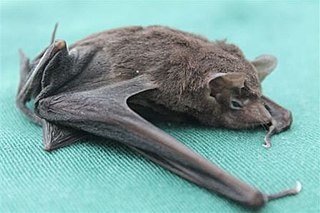
The Seychelles sheath-tailed bat is a sac-winged bat found in the central granitic islands of the Seychelles. They are nocturnal insectivores that roost communally in caves. The species was previously abundant across much of the archipelago, but has since seen a substantial loss of habitat. The International Union for Conservation of Nature has listed the species as being critically endangered, due to population decline. This is mainly due to an increase in land development and the introduction of invasive species.
When an echolocating bat approaches a target, its outgoing sounds return as echoes, which are Doppler shifted upward in frequency. In certain species of bats, which produce constant frequency (CF) echolocation calls, the bats compensate for the Doppler shift by changing their call frequency as they change speed towards a target. This keeps the returning echo in the same frequency range of the normal echolocation call. This dynamic frequency modulation is called the Doppler shift compensation (DSC), and was discovered by Hans Schnitzler in 1968.

The cinnamon red bat is a species of bat in the family Vespertilionidae. It was first described from a specimen that had been collected in Chile. For more than one hundred years after its initial description, it was largely considered a synonym of the eastern red bat. From the 1980s onward, it was frequently recognized as distinct from the eastern red bat due to its fur coloration and differences in range. It has deep red fur, lacking white "frosting" on the tips of individual hairs seen in other members of Lasiurus. It has a forearm length of 39–42 mm (1.5–1.7 in) and a weight of 9.5–11.0 g (0.34–0.39 oz).

The elegant myotis is a species of vesper bat found in Belize, Costa Rica, El Salvador, Guatemala, Honduras, Mexico, and Nicaragua.

The western red bat or desert red bat is a species of microbat in the family Vespertilionidae. It is found in western North America and Central America.
The Paraguana moustached bat occurs only on the Paraguaná Peninsula of Venezuela. The entire population uses three caves, one of which is subject to human vandalism. Their total range is less than 400 km2 (150 sq mi). In 2008, the caves where the bat is found were protected by the creation of the Cuevas de Paraguaná Wildlife Sanctuary–the first wildlife sanctuary in Venezuela.
